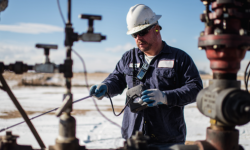Why Can’t We Achieve Safety Excellence? by F. David Pierce. Available from <http://www.ehstoday.com/safety-leadership/why-can-t-we-achieve-safety-excellence> [Aug 07, 2017]
I entered the industrial world as an industrial hygienst many years ago, before the Occupational Safety and Health Act established basic safety and health rules for workplaces. The voluntary safety and health world back then wasn’t very effective; to use today’s jargon, it had high variation.
When I started my career, a few companies made honest attempts to make work safer. A larger percentage of industry didn’t make any attempt, and the largest percentage of industry made some effort if it was convenient or cost-effective for them at the time.
My first job was at a company that did not make an attempt to embrace workplace safety excellence. I remember having to climb to the top of a pilot plant chlorinator where the atmosphere was greater than 25 percent carbon monoxide, 25 percent escaped chlorine and about 140 degrees. There was no thought about how to make it safer. It was accepted practice to supply the worker with a new respirator canister before making each climb to the top.
Leaving work one day at dusk, I thought I was seeing a dark tent in the air ahead of me and stopped walking. It turned out to be a large cloud of chlorine, and if I had walked into it, I might not be writing about it.
Since then, OSHA regulations have reduced the high safety variation in industry and have improved the safety and health of workers – just look at the declining injury and fatality numbers. The real question is why haven’t we been able to create extremely safe workplaces across American industry? Why doesn’t every American company have world-class safety performance? Is severely injuring between 2 and 5 percent of America’s workers the best we can do?
Joel Barker, a futurist in the 1990s, asked this “paradigm shift” question: “What is considered impossible today, but if weren’t, would fundamentally change a company, an industry, technology, the world?”
Too often, we never deeply consider how to change or do things that all of us know is impossible to do. To a logical mind, that seems like a fool’s errand. But Barker’s belief was that deeply considering and challenging what is known to be impossible opens the door of possibility and could have huge, positive rewards.
As a long-time student of critical thinkers, I’ve been thinking about, talking about, writing about and lecturing about this paradigm shift question for almost 50 years now: Why can’t we get world-class safety and health performance across all of American industry?
There are three reasons why we haven’t been able to achieve safety and health excellence in America. The first impediment is industry itself and industry management and management. The second are paradigms that are accepted without challenge and continue to keep us from moving toward world-class safety and health. The third is us – the safety community – which will be addressed in the second part of this two-part article.
Industry, Management and Company Leadership
When the OSH Act was passed, Congress’ belief was that the new rules would force workplaces to create safe work environments. You can read this in the standard’s opening section where each employer is charged with providing a workplace that is free of recognized hazards. From industry’s perspective at the time, this was considered adversarial, anti-business and anti-profit.
Today, you don’t hear resounding anti-OSHA statements made by industry leaders like those that were common in the 1970’s. You hear pro-safety messages and you hear that safety is a fundamental value of the company or that the employees are that company’s most important asset. But is it, or are they? Actions always speak louder than words.
Industry increasingly relies on passion for safety rather than safety skills. More than half of those who provide safety services within industry do not consider themselves “safety professionals.” They are called “safety technicians” or “safety specialists” or some similar term. They are put in their positions because of the passion that they hold for worker safety, not because of having an educational background in a safety-related discipline or an aptitude for safety.
This non-professional “safety person” demographic gets greater as smaller enterprises become a greater percentage of industry (“Small Business Trends: Small Business, Big Impact,” Small Business Administration, http://www.sba.gov).
Companies often don’t invest in education for these critically important safety people, or they feel that sending them to an OSHA 10-hour or 30-hour course gives them the skills that they need. Is it important to know OSHA regulations? Of course it is, but compliance is the low-bar of safety; it will never take any company to world-class safety performance.
True change, including improving safety performance, is rare in industry. In the vast majority of American companies, the focus of business or process improvement changes every week because American industry lacks the courage or ability to stay the course of change.
I personally have seen this in action throughout my career. A company has failing safety performance, perhaps has difficulty getting workers’ compensation insurance or has an extremely high premium based on high NCCI ratings. Perhaps the company is attempting to implement lean manufacturing practices or Six Sigma continuous improvement.
Corporate leaders adopt the new lingo, talk about the importance of continuous improvement and merging lean principles with safety improvement and tout the importance of having excellent safety performance, but don’t stay the course for whatever reason. Maybe they don’t know how to effectively deal with the complaints and fear that change brings, or they only half-heartedly believe in the value of changing. Maybe the entire management chain isn’t aligned to the change, so mixed messages become the norm.
When Safety Is a Cost
Sometimes, corporate leaders consider safety improvement only from the debt-side of the balance sheet and cannot see safety as more than a non-value-added cost to be subtracted from profits. They fail to understand the critical importance of worker safety as a value-adding, non-negotiable asset.
Psychologists have known for more than a century that if you focus on preventing a negative, it not only is frustrating and demoralizing, but it only returns a half-hearted effort. It’s like a football team having a game plan that focuses on preventing the other team from scoring and fails to focus on their offensive excellence.
American business leaders make this same fatal mistake and wonder why they can’t reduce costs. They celebrate lowering their workers’ compensation costs and miss the correlation to keeping employees at work, happy and productive.
Part of the disconnect is that 99 percent of business and management schools never talk about, teach or build an understanding of workplace safety in their Baccalaureate or MBA programs (Siedel, George J., Law and Business School Curriculum, BizEd, the AACSB International, March 15, 2017). It’s hard to imagine that this critical element – protecting your greatest asset – is totally missed, but it is.
Business schools focus on understanding economics, accounting, marketing, management and even problem-solving, but worker safety is seldom included. Why is this missed? Most business school deans haven’t earned hard knocks in company trenches. They’ve learned their craft from the academic side only. They were never taught safety in their management or business classes, so they never think about it.
This lack of consideration for safety performance – beyond the business value of reducing workers’ compensation costs – is a serious disconnect in leadership thinking and is a major cause of leaders talking the safety talk but not walking the safety walk. Safety is not considered a value-adding enhancement to the business.
We perpetuate this by the way we talk about and “sell” safety. We say, “A lost-time injury will cost you $120,000,” the implication being that additional investment should be made in safety to reduce or eliminate those costs. This won’t sway management and it further entrenches the debit-reduction thinking that kills good safety programs.
Accepted and Limiting Paradigms
Joel Barker, who pioneered the reintroduction of this term, defines a paradigm as a pattern that is widely held and is used to interpret or determine successful solutions. Many paradigms we have and use are valuable to us because we respond quickly when we confront issues or information that align with our paradigms. If it agrees, we don’t even have to apply a lot of thought, it’s good or valid. If it disagrees, we quickly reject it without much thought.
Paradigms also can be highly limiting and cause us to believe things that just aren’t true. Let me introduce several paradigms that widely are believed without thoughtful challenge and because of that, keep us from obtaining world-class safety and health performance.
Ever heard the paradigm, “Accidents happen?” This paradigm is both real and subtle. It is real because most people believe it to be true. It is subtle – especially to safety and health practitioners – because we counter that all accidents are caused and all causes can be removed, avoided or minimized. However, we also acknowledge that due to human factors, accidents cannot be totally removed. So, even safety professionals, who are dedicated to making work safe, own a piece of this paradigm.
A common result of believing this paradigm is that we give minor attention to little accidents – we may not even investigate them – and we may not identify corrective actions or put them in place.
This is the power of a paradigm, as passing over minor accidents or near-misses is a common practice in the vast majority of safety programs. I’m not trying to make you uncomfortable or defensive, but if we own a piece of this paradigm, we also must own the common results.
What if all of us truly believed that “accidents don’t happen?” How would that change the paradigm? It would be a 180-degree change. We would insist that every accident and near-miss be fully investigated, the causes fully determined and effective actions identified, tracked and put in place. What would be the long-term results of this different reaction to accidents? Quite possibly, less future accidents, a non-recurrence of events and safer workplaces.
Ever heard the paradigm: “Safety is easy?” This isn’t a common paradigm for safety and health professionals who spend countless hours battling in the trenches. We know that safety isn’t easy, but we also need to acknowledge that this paradigm is accepted by many of our business leaders. Why else would passion for safety be the major requirement for filling safety positions?
The unavoidable result of believing this paradigm is that anyone can learn safety. In reality, the safety function rarely gets the level of respect that engineering gets, that marketing gets or that quality gets, because the paradigm doesn’t apply to those functions. They aren’t easy; they are complex and they are difficult.
Being passionate about engineering or marketing wouldn’t even be the starting point for that position. Management would insist on education, experience and success to consider hiring for one of those positions. Can you see the power of this paradigm?
What would be the results if this paradigm was: “Safety isn’t easy?” Then the two differences that we just introduced about hiring engineers and market specialists would apply to safety and health jobs. There would be a higher demand for new safety education programs and for job applicants with degrees related to occupational safety and health.
It would be a huge change. The safety function would have a higher respect level and would receive greater attention from leaders.
Ever heard this common paradigm: “Awareness is the key?” This paradigm is common in business leadership and sadly, among a lot of safety and health professionals as well. The paradigm focuses on individual vigilance as the key to safe performance. It’s been the foundation of safety incentive programs for 100 years: if workers are eligible to receive a reward, they will keep their own safety awareness high every minute they worked.
This paradigm is displayed when an upswing in injuries occurs or a serious injury happens. Management and the safety department call for a stand-down, where work stops for 10 minutes and a “get your heads in the game” speech is given to all employees. Does it work to turn injury performance around? Commonly yes, but not because of the paradigm.
Awareness is not the reason for the sudden change; the Hawthorne Effect is the reason. The Hawthorne Effect is a phrase coined for the short-term alteration of behavior by the subjects of a study due to their awareness of being observed. It was first coined by Henry A. Lansberger in 1958 while analyzing experiments at the Hawthorne Works outside of Chicago.
The keyword in that paradigm shouldn’t be “awareness.” It should be “engagement.” So, our challenge is to educate leaders and our safety community to acknowledge the correct paradigm is: “Engagement is the key!”
(Part 2 of this article will appear in the September issue of EHS Today and will discuss how safety professionals impede safety excellence.)
F. David Pierce holds a master’s degree in industrial hygiene from the University of Utah and multiple safety and health certifications. He has published five books and 100 articles about safety management. He currently resides in Salt Lake City, and is principle consultant in Leadership Solutions Consultants Inc.
Why Can’t We Achieve Safety Excellence? by F. David Pierce. Available from <http://www.ehstoday.com/safety-leadership/why-can-t-we-achieve-safety-excellence> [Aug 07, 2017]









